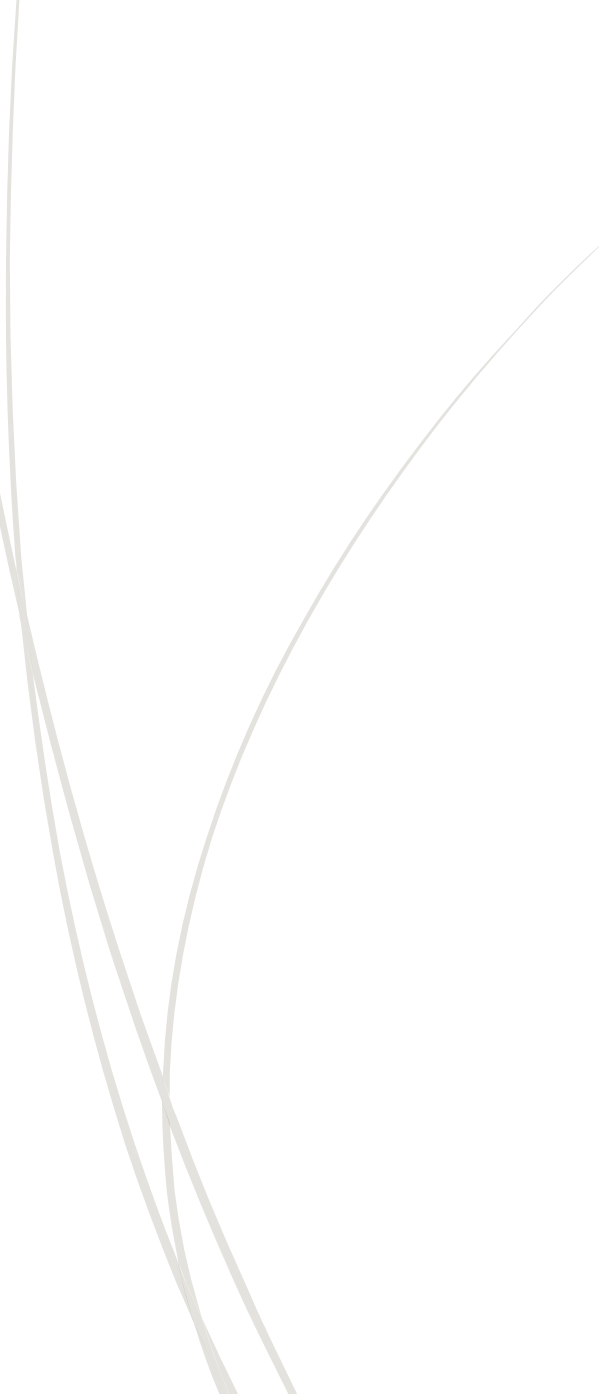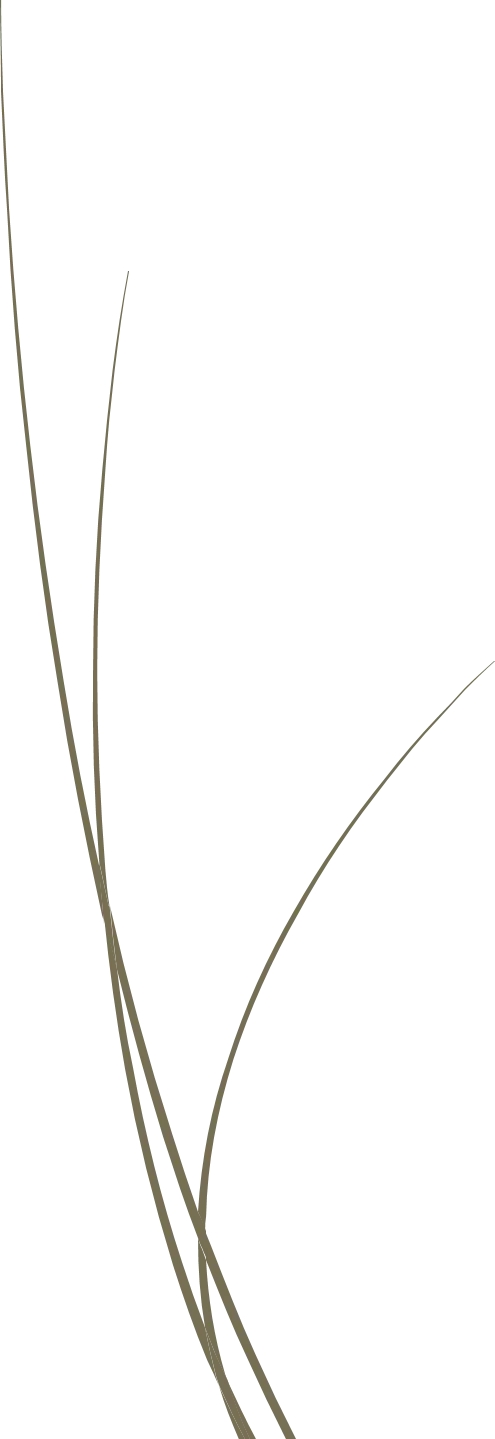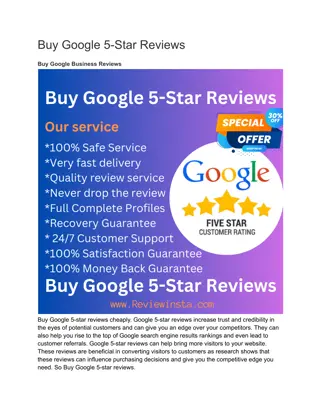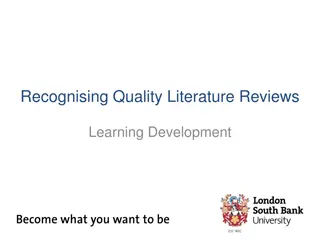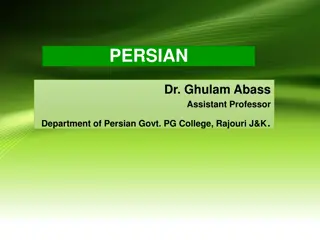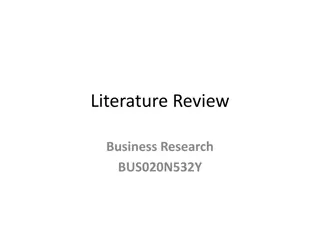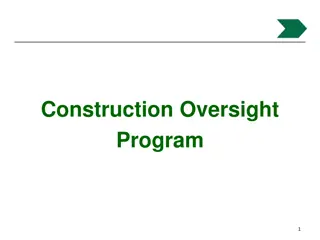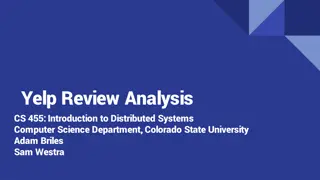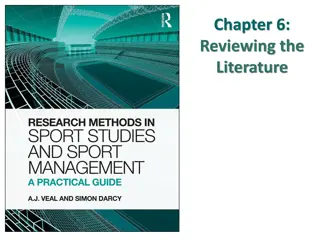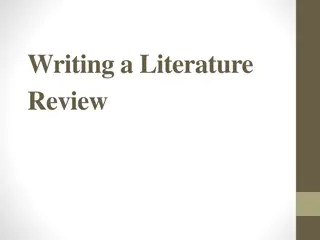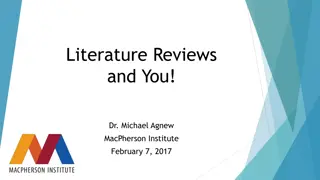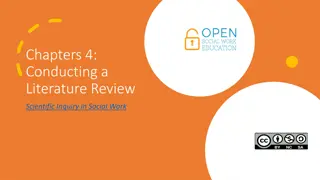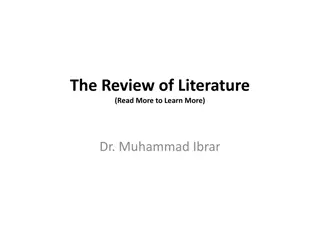Understanding Literature Reviews: Process, Purpose, and Types
A literature review is an essential part of academic research, providing a synthesis of existing studies on a topic. It involves reviewing published information within a specific subject area to help the reader understand the research background. The process of conducting a literature review is meticulous and requires thorough research. Different types of reviews, such as evaluative, exploratory, instrumental, and systematic, serve various purposes in academic research.
Download Presentation

Please find below an Image/Link to download the presentation.
The content on the website is provided AS IS for your information and personal use only. It may not be sold, licensed, or shared on other websites without obtaining consent from the author. Download presentation by click this link. If you encounter any issues during the download, it is possible that the publisher has removed the file from their server.
E N D
Presentation Transcript
Review of Related Literature: Need, Purpose & Planning Dr. Gopal Singh Department of Education CSJM University, Kanpur Email: drgopalsingh5@gmail.com
Learning Objectives After studying this chapter, you should be able to understand: What is meant by literature review? Functions of literature review Steps of literature review
Meaning (Re + View) to view or see again. to examine or study again especially to reexamine judicially. to look back on : take a retrospective view of review the past. to go over or examine critically or deliberately reviewed the results of the study. to give a critical evaluation
What is Literature review A literature review discusses published information in a particular subject area, and sometimes information in a particular subject area within a certain time period. A literature review can be just a simple summary of the sources, but it usually has an organizational pattern and combines both summary and synthesis. The format of a review of literature may vary from discipline to discipline and from assignment to assignment. A review may be a self-contained unit.
Literature Review : A Process The literature review: A synthesis of studies on any given topic. Usually precedes a full-length original study as a way of introducing the general topic. Its purpose: To help the reader understand the background to your study and see how it s the next logical study to be conducted in this domain. Necessarily, a good literature review requires a thoroughly researched topic. Be prepared for a writing process. Do not attempt to write a literature review over night. This process takes weeks and months. Yes, months.
TYPES OF REVIEW The literature review can be classified and studies can be placed under following types: Evaluative Review Exploratory Review Instrumental Review Systematic Review
Evaluative Review Evaluative review focuses on the findings of the researches. The evaluative review is already reviewed and evaluated by experts. This type of review provides idea about the worth of the researchers study as it has been compared by the researchers.
Exploratory Review Exploratory review tells what are the best explored researches its outcomes and the areas still to be explored. This review provides direction to the researcher to choose the best way to study and gives idea about areas that are to be considered for the study
Instrumental Review Instrumental review does not tell about the research but tells how to conduct and proceed with the research. This research provides researcher the best way to conduct the research.
Systematic Review Systematic review critically analyses the researches, its procedures, methodology, analysis and the result. This type of review helps the researcher to sort the researches needed for the current study.
Why write Literature Review? The purpose of a literature review is for you to take a critical look at the literature (facts and views) that already exists in the area you are researching. Literature can include books, journal articles, internet (electronic journals), newspapers, magazines, theses and dissertations, conference proceedings, reports, and documentaries. Literature reviews are written humanities, but mostly in the sciences and social sciences; in experiment and lab reports, they constitute a section of the paper. Sometimes a literature review is written as a paper in itself. occasionally in the
In the context of a research paper on a thesis, the literature review provides a background to the study being proposed. The background may consider one or more of the following aspects depending on the research question being posed: Theoretical background past, present or future Clinical practice previous or contemporary Methodology and/or research methods Previous findings Rationale and/or relevance of the current study
Bring clarity and focus to your research problem Improves methodology Broaden your knowledge base in your research area Contextualize your findings The problem identified by you has already been researched. Will help in forming research questions. Will get an idea of how to proceed with design of the study. Can identify appropriate data collection instruments.
shows changes in a particular field over time, from early research to the most recent developments clarifies areas of controversy and consensus among scholars, as well as dominant views within the field identifies research gaps and justifies your research by indicating the contribution it will make to the field
What should I do before writing the literature review? Clarify If your assignment is not very specific, seek clarification from your supervisor/lecturer: Roughly how many sources should you include? What types of sources (books, journal articles, websites)? Should you summarize, synthesize, or critique your sources by discussing a common theme or issue? Should you evaluate your sources? Should you provide subheadings and other background information, such as definitions and/or a history?
Find models Look for other literature reviews in your area of interest or in the discipline and read them to get a sense of the types of themes you might want to look for in your own research or ways to organize your final review. You can simply put the word "review" in your search engine along with your other topic terms to find articles of this type on the Internet or in an electronic database. The bibliography or reference section of sources you've already read are also excellent entry points into your own research.
Narrow your topic There are hundreds or even thousands of articles and books on most areas of study. The narrower your topic, the easier it will be to limit the number of sources you need to read in order to get a good survey of the material. Your instructor will probably not expect you to read everything that's out there on the topic, but you'll make your job easier if you first limit your scope.
Consider whether your sources are current Some disciplines require that you use information that is as current as possible. In the sciences, for instance, treatments for medical problems are constantly changing according to the latest studies. Information even two years old could be obsolete.
However, if you are writing a review in the humanities, history, or social sciences, a survey of the history of the literature may be what is needed, because what is important is how perspectives have changed through the years or within a certain time period. Try sorting through some other current bibliographies or literature reviews in the field to get a sense of what your discipline expects. You can also use this method to consider what is "hot" and what is not.
Find a focus A literature review, like a term paper, is usually organized around ideas, not the sources themselves as an annotated bibliography would be organized. This means that you will not just simply list your sources and go into detail about each one of them, one at a time.
As you read widely but selectively in your topic area, consider instead what themes or issues connect your sources together. Do they present one or different solutions? Is there an aspect of the field that is missing? How well do they present the material and do they portray it according to an appropriate theory? Do they reveal a trend in the field? A raging debate? Pick one of these themes to focus the organization of your review.
Construct a working thesis statement Then use the focus you've found to construct a thesis statement. Yes! Literature statements as well! However, your thesis statement will not necessarily argue for a position or an opinion; rather it will argue for a particular perspective on the material. reviews have thesis
Some sample thesis statements for literature reviews are as follows: The current trend in treatment for congestive heart failure combines surgery and medicine. More and more cultural studies scholars are accepting popular media as a subject worthy of academic consideration.
Consider organization You've got a focus, and you've narrowed it down to a thesis statement. Now what is the most effective way of presenting the information? What are the most important topics, subtopics, etc., that your review needs to include? And in what order should you present them?
Develop an organization for your review at both a global and local level: First, cover the basic categories Just like most academic papers, literature reviews also must contain at least three basic elements: an introduction or background information section; the body of the review containing the discussion of sources; and, finally, a conclusion and/or recommendations section to end the paper.
Introduction: Gives a quick idea of the topic of the literature review, such as the central theme or organizational pattern. Body: Contains your discussion of sources and is organized either chronologically, thematically, or methodologically (see below for more information on each). Conclusions/Recommendations: Discuss what you have drawn from reviewing literature so far. Where might the discussion proceed?
The introduction should provide the reader with the scale and structure of your review. It serves as a kind of map. The body of the review depends on how you have organized your key points. postgraduate level should be evaluative and not merely descriptive. For example possible reasons for similarities or differences between studies are considered rather than a mere identification of them. The conclusion of the review needs to sum up the main findings of your research into the literature. The findings can be related to the aims of the study you are proposing to do. The reader is thus provided with a coherent background to the current study. Literature reviews at
Organizing the body Once you have the basic categories in place, then you must consider how you will present the sources themselves within the body of your paper. Create an organizational method to focus this section even further. To help you come up with an overall organizational framework for your review, consider the six typical ways of organizing the sources into a review: oChronological oBy publication oBy trend oThematic oMethodological oQuestions for Further Research
Similar to primary research, development of the literature review requires four stages: Problem formulation which topic or field is being examined and what are its component issues? Literature search finding materials relevant to the subject being explored Data evaluation determining which literature makes a significant contribution to the understanding of the topic Analysis and interpretation discussing the findings and conclusions of pertinent literature
What should you write? the accepted facts in the area the popular opinion the main variables the relationship between concepts and variables shortcomings in the existing findings limitations in the methods used in the existing findings the relevance of your research suggestions for further research in the area.
Literature reviews should comprise the following elements: An overview of the subject, issue or theory under consideration, along with the objectives of the literature review Division of works under review into categories (e.g. those in support of a particular position, those against, and those offering alternative theses entirely) Explanation of how each work is similar to and how it varies from the others Conclusions as to which pieces are best considered in their argument, are most convincing of their opinions, and make the greatest contribution to the understanding and development of their area of research
In assessing each piece, consideration should be given to: Provenance What are the author's credentials? Are the author's arguments supported by evidence (e.g. primary historical material, case studies, narratives, statistics, recent scientific findings)? Objectivity Is the author's perspective even-handed or prejudicial? Is contrary data considered or is certain pertinent information ignored to prove the author's point? Persuasiveness Which of the author's theses are most/least convincing? Value Are the author's arguments and conclusions convincing? Does the work ultimately contribute in any significant way to an understanding of the subject?
Layout : Make your literature review have an academic and professional appearance. Here are some points to make the look of your report appealing to the reader White space: leave space between sections, especially from the abstract. This gives an uncluttered effect. Headings/sub-headings: these help to separate ideas. Text boxes: you can use these for quotations or paraphrasing to separate them from the rest of your text. It is also pleasing to the eye.
Graphics: centre your graphics, such as diagrams or tables, to have space around them. Try not to bury graphics in your text. Pagination: you can number pages or sections or both, but the important thing to do is to be consistent. The cover page normally is not numbered. The content page and abstract page usually have a separate numbering system to the body of your literature review.
Language focus Create a balance between direct quotation (citation) and paraphrasing. Avoid too much direct quoting. The verb tense chosen depends on your emphasis: When you are citing a specific author's findings, use the past tense: (found, demonstrated); When you are writing about an accepted fact, use the present tense: (demonstrates, finds); and When you are citing several authors or making a general statement, use the present perfect tense: (have shown, have found, little research has been done).
Final checklist Have I fulfilled the purpose of the literature review? Is it written at a level appropriate to its audience? Are its facts correct? Is all the information included relevant? Are the layout and presentation easy on the eye? Is the language clear, concise and academic? Does the abstract summarise the entire review? Does the introduction adequately introduce the topic?
Is the body organised logically? Does the conclusion interpret, analyse and evaluate? Are the recommendations reasonable? Does the table of contents correspond with the actual contents? Are page numbers correct? Have I acknowledged all sources of information through correct referencing? Have I checked spelling, grammar and punctuation? Have I carefully proof-read the final draft?
How to review? The whole process of reviewing includes: a. Searching for literature b. Sorting and prioritizing the retrieved literature c. Analytical reading of papers d. Evaluative reading of papers e. Comparison across studies f. Organizing the content g. Writing the review
Comparison across studies The aim is to extract key points by comparing and contrasting ACROSS studies, instead of reading one paper after another. Key points for a review may concern areas of similarities and/or differences in: Research aim(s) or hypotheses Research design and sampling Instruments and procedures used How data were analysed Results or findings Interpretations
Find similarities and differences between studies at different levels, e.g.: - philosophy - epistemology - morality - methodology - methods - types of data - data analysis - interpretation
Set out your thinking on paper through maps and trees. Feature map Classifies and categorises your thought in tabular form Links between concepts and processes, or shows relationship between ideas and practice Concept map Shows how topic branches out into subthemes and related questions or represents stages in the development of a topic. Tree construction
Tips on writing Express one idea in a sentence. Ensure that all your sentences have a subject, verb and object. Group sentences that express and develop one aspect of your topic. Use a new paragraph for another aspect or another topic. Use sentences and paragraphs with appropriate use of commas, colours and semi-colours. Incorrect use of punctuation can affect the meaning. Use words that link paragraphs and which show contrast and development to your argument e.g. hence , therefore , but , thus , as a result , in contrast . Sentences Paragraphs Consistent Grammar Transition Words
Pitfalls - Vagueness due to too much or inappropriate generalisations - Limited range - Insufficient information - Irrelevant material - Omission of contrasting view - Omission of recent work
Early works have addressed some of the problems and issues discussed in video retrieval. Researchers have developed ideas and tools for supporting video editing, for example in [8]. They have defined a seamless video editing in the gradient domain. The spatio-temporal gradient fields of target videos are modified or mixed to generate a new gradient field, which is usually not integrate able. They have also described how semantic information about video can be structured and used for content-based access. From a general video archive point of view, the problem with this tool is the lack of support for managing video document structures. A digital video archive serving different categories of users should offer a more structured way of describing video contents
Srivastava, S. (2014). Studies science achievement as predictor of scientific attitude. The researcher describes how science achievement predicts scientific attitude of secondary school students. For this study, researcher collected a sample of 480 IX standard students which includes 240 girls and 240 boys through multistage random sampling. The scientific attitude questionnaire by K S Mishra was adopted by researcher for studying scientific attitude of secondary students. Science achievement test was developed by investigator to measure science achievement of secondary school students. The analysis was done by using t-test and product moment correlation as a statistical tool. The findings states that girls shows more ability to apply knowledge in science than the boys of secondary class but both the gender does not differ in knowledge and comprehension in science from one another. It indicates that female students with high achievement in science are more likely to have high level of scientific attitude in intent as well as action while achievement in science do not influence scientific attitude in intent as well as action among male students. Findings indicate that male students with more ability to comprehend in science are not likely to have better scientific attitude in their action. Perhaps male students perceive more stress in their environment and it might negatively affect the development of scientific attitude in action. So, science educators should provide more personal autonomy to male students and increase their motivation for learning science.
SCOPE OF REVIEW How many studies do you need to look at? How comprehensive should it be? How many years should it cover?
TYPES OF SOURCES Primary Sources Secondary Sources
PRIMARY SOURCES Primary sources were either created during the time period being studied or were created at a later date by a participant in the events being studied, such as, a childhood memoir. They are original documents (i.e., they are not about another document or account) individual viewpoint of a participant or observer. Primary sources represent direct, uninterpreted records of the subject of your research study. and reflect the
EXAMPLES OF PRIMARY DOCUMENTS YOU COULD REVIEW AS PART OF YOUR OVERALL STUDY INCLUDE Artifacts (e.g. furniture or clothing, all from the time under study); Audio recordings (e.g. radio programs) Diaries; * Internet communications on email, Interviews (e.g., oral histories, telephone, e-mail); Letters; * Newspaper articles written at the time; Original Documents (i.e. birth certificate, will, marriage license, trial transcript); Patents;
Photographs Proceedings of Meetings, conferences and symposia; Records of organizations, government agencies (e.g. annual report, treaty, constitution, government document); Speeches; Survey Research (e.g., market surveys, public opinion polls); Transcripts of radio and television programs Video recordings; Works of art, architecture, literature, and music (e.g., paintings, sculptures, musical scores, buildings, novels, poems)


